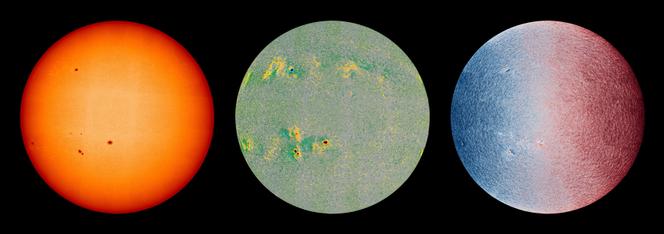


These three colored discs, published by the European Space Agency (ESA) on November 20 – along with a fourth with more explosive contours – are photos of the Sun taken by the Solar Orbiter probe on March 22, 2023. Each is a composite of 25 images taken by the probe, then 74 million kilometers from the Sun. The orange ball, a classic visible-light image, reveals the gaseous surface with a temperature of between 4,500°C and 6,000°C. The spots are colder regions.
The greenish disc is a kind of planisphere of the Sun's magnetic field. This magnetogram shows that the magnetic field is concentrated in the regions of the sunspot, with outward-oriented fields shown in red and inward-oriented fields in blue. The same camera can record the movement of matter on the Sun's surface (depicted in the third disc), where blue indicates movement toward the lens and red indicates movement away. This tachogram reveals that plasma is being pushed outward around sunspots. These photos of unrivaled quality can be spectacularly zoomed in on the ESA website.
The fourth photo featured in this publication is of the Sun's corona. This glowing outer atmosphere lies above the photosphere, the Sun's visible surface. It was photographed by the space probe's Extreme Ultraviolet Imager. This 1 million-degree plasma follows the magnetic field lines that emerge from the Sun, often linking nearby sunspots.
The quality of the images thus assembled enables details of our star's surface to be observed. In its press release, the ESA pointed out that, in its mosaics of 25 photos, the solar disk has a diameter of almost 8,000 pixels.
Costing a total of €1.5 billion, the Solar Orbiter mission, piloted by the European agency in collaboration with NASA, took off in February 2020. Gradually moving out of the ecliptic plane, where the planets revolve around the Sun, it will be the first probe to photograph the poles of the Sun.
The plane in which the Solar Orbiter orbits the Sun will be tilted by 24 degrees to the ecliptic by 2027, rising to 33 degrees by 2030. To withstand the heat, a shield designed to withstand a maximum temperature of 520°C protects the probe, and each of its 10 measuring instruments or cameras is equipped with portholes that can only be opened when they are switched on.
